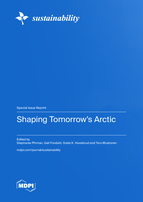Shaping Tomorrow’s Arctic
A special issue of Sustainability (ISSN 2071-1050). This special issue belongs to the section "Air, Climate Change and Sustainability".
Deadline for manuscript submissions: closed (18 October 2021) | Viewed by 36497
Special Issue Editors
Interests: arctic climate and environmental change; sea ice origins; trajectories and change; responding to change; novel educational approaches; interdisciplinary research; education and career advancement
Interests: legal geographies of indigenous land rights in Russian North; cultural geographies of reindeer husbandry in Russian North; human development in Circumpolar North; sustainable development in North
2. Faculty of Social Science, Nord University, 8049 Bodø, Norway
Interests: arctic development; adaptation to climate change; societal transformation to low emission society; sustainable adaptation; coproduction of knowledge; local communities; indigenous people and nature-based livelihoods; socio-political change in svalbard; interdisciplinary approach to arctic change; multiple stressors and cascading effects; coastal communities and livelihoods
Special Issue Information
Dear Colleagues,
Decisions made now are fundamentally shaping the multiple Arctics of 2050. This Special Issue explores the past, present and future of Arctic sustainability. What are possible Arctic futures? How does the current path dependency on fossil fuels interplay with the need for long term Arctic sustainability? What do trajectories towards sustainable Arctics look like? How might these differ for different arctic populations? What are the effects of human activities in the Arctic on local environmental conditions? What can we do to reduce disruptions and mitigate impacts? How do the current and projected changes in climate affect issues of Indigenous rights, rights to resources and human rights? Do we have the proper tools, mechanisms and regulations to manage the multiple Arctics? How do we ensure involvement in decision-making for sustainability? How do we decide on directions for management and development of arctic resources, and what voices are missing? What steps should we be taking now, such as coproducing knowledge for sustainability, to lay the foundation for an equitable, just and inclusive Arctic? How do visual arts, literature, performing arts, etc. advance sustainability in the Arctic? How is security being reimagined and redefined in the Arctic? In looking forward, what can we learn from past experiences, as well as from recent responses to change?
We invite contributions that advance our understanding of Arctic sustainability from all disciplines (humanities; natural, social and physical sciences) and viewpoints, and from local, national, regional, and international perspectives. The scope of this Special Issue ranges from approaches to education, capacity building, governance, history, cultural studies, societal transformation, community viability, post petroleum futures and biophysical projections, to options for mitigating, adapting and transforming to change and impacts.
We welcome research articles and reviews that provide updates on the latest progress on critical issues as well as communications, short notes and manuscripts regarding research proposals and research ideas. Of special interest are articles and communications from arctic residents, indigenous persons, and early career scholars.
Prof. Dr. Stephanie PfirmanProf. Dr. Gail Fondahl
Prof. Dr. Grete K. Hovelsrud
Dr. Tero Mustonen
Guest Editors
Manuscript Submission Information
Manuscripts should be submitted online at www.mdpi.com by registering and logging in to this website. Once you are registered, click here to go to the submission form. Manuscripts can be submitted until the deadline. All submissions that pass pre-check are peer-reviewed. Accepted papers will be published continuously in the journal (as soon as accepted) and will be listed together on the special issue website. Research articles, review articles as well as short communications are invited. For planned papers, a title and short abstract (about 100 words) can be sent to the Editorial Office for announcement on this website.
Submitted manuscripts should not have been published previously, nor be under consideration for publication elsewhere (except conference proceedings papers). All manuscripts are thoroughly refereed through a single-blind peer-review process. A guide for authors and other relevant information for submission of manuscripts is available on the Instructions for Authors page. Sustainability is an international peer-reviewed open access semimonthly journal published by MDPI.
Please visit the Instructions for Authors page before submitting a manuscript. The Article Processing Charge (APC) for publication in this open access journal is 2400 CHF (Swiss Francs). Submitted papers should be well formatted and use good English. Authors may use MDPI's English editing service prior to publication or during author revisions.
Keywords
- Arctic
- sustainability
- Sustainable Development Goals/SDGs
- futures
- climate change
- history
- Indigenous peoples
- local involvement
- communities
- coproduction
- rights
- equity
- justice
- governance
- adaptation
- mitigation
- resilience
- interdisciplinarity
- multiple Arctics









